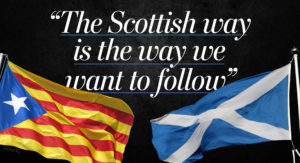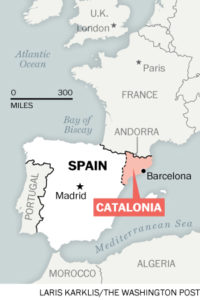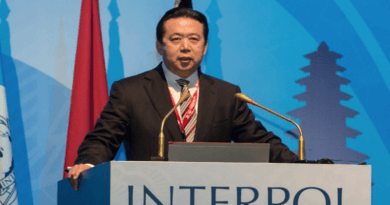As Scotland relaunches its independence bid, Catalonia has its own plan
Ishaan Tharoor, The Washington Post | March 29, 2017
The Scottish Parliament has backed a second bid for secession from Britain, approving a motion that supports making a formal request to Westminster for the powers to hold a new referendum on independence. The motion, which was pushed by Nicola Sturgeon, Scotland’s first minister and a pro-secession leader, came just hours ahead of Britain’s own move on Wednesday to initiate the process of leaving the European Union.
 Unlike their English counterparts, a majority of Scottish voters wanted to remain in the European Union last summer. Sturgeon and her Scottish National Party have channeled their ire to revive Scotland’s independence bid, which was defeated in a 2014 referendum.
Unlike their English counterparts, a majority of Scottish voters wanted to remain in the European Union last summer. Sturgeon and her Scottish National Party have channeled their ire to revive Scotland’s independence bid, which was defeated in a 2014 referendum.
“When the nature of the change made inevitable by Brexit becomes clear, it should not be imposed upon us,” Sturgeon argued in a speech on Tuesday. “We should have the right to decide.”
Now Sturgeon faces a clash with British Prime Minister Theresa May. May has not outright rejected the prospect of another binding Scottish referendum, but she is adamant that any negotiations over Scotland’s future take place only after Britain has settled the terms of its divorce with Europe. Sturgeon, however, wants the referendum to be held by the spring of 2019 — roughly the same time Brexit will likely be finalized. The British government is dead set against that time frame and may seek to block or delay a second Scottish referendum until the early 2020s.
This may all seem tense and messy, but the situation looks almost ideal to certain observers.
“The Scottish way is the way we want to follow,” said Carles Puigdemont, president of the government of Catalonia, a region in the northeastern corner of Spain. Puigdemont spoke to Today’s WorldView during a visit to Washington and likened Catalonia’s independence aspirations to those in Scotland. “Catalonia and Scotland are very different, of course, but our demands are the same. We want to vote in a referendum for independence.”
Unlike Britain, the Spanish government has categorically refused to discuss the possibility of a referendum. Earlier this month, a Spanish court banned a former Catalan leader from holding office for two years, punishment for organizing a nonbinding, symbolic referendum in 2014. Puigdemont is determined to stage a referendum before the end of September — whether Madrid recognizes it or not.
 “Spain has an idea about its unity like a religion. It’s like an idea of God,” said Puigdemont, claiming that Madrid is in denial about the level of support for Catalan independence. “They don’t want to talk about it, but it exists.”
“Spain has an idea about its unity like a religion. It’s like an idea of God,” said Puigdemont, claiming that Madrid is in denial about the level of support for Catalan independence. “They don’t want to talk about it, but it exists.”
The arguments for Catalan independence are not new. The region has its own distinct sense of culture and history, including a local government that traces its origins directly back to the 14th century. Its population of 7.5 million is similar in size to a number of other E.U. member states. Catalonia accounts for roughly a fifth of Spain’s gross domestic product; in
Barcelona, it already has a putative capital that is a thriving, global metropolis.
The region’s independence movement picked up steam in the wake of the global financial crisis and growing frustrations over Spain’s entrenched political dysfunction. After years of mass pro-independence protests, a symbolic independence vote and a local election victory by a coalition of pro-secessionist parties, Puigdemont says there is a democratic mandate to push for a referendum.
“What kind of answer does the Spanish state have for this reality?” he asked. “There’s a very large number of Catalans who don’t want to be part of the Spanish state. We ask to exercise our right to self-determination.”
Critics, though, say the independence movement is losing steam and may not even command majority support in Catalonia. While Puigdemont toured the United States, Spanish Prime Minister Mariano Rajoy ventured to Catalonia this week with an ambitious infrastructure investment plan. Rajoy, a center-right politician and staunch opponent of Catalan independence, suggested there was no process by which Puigdemont and his allies could achieve their goals.
“In order to have an agreed-upon referendum, it would first be necessary to create a new constitution that would eliminate the concept of national sovereignty,” Rajoy told a Catalan newspaper. “It’s not up to us; it’s up to the whole of the Spanish people.”
Even gestures of conciliation are at an impasse: Puigdemont said he is open to dialogue with Madrid about the conditions and terms of the proposed referendum; Rajoy, in an interview with El Pais last week, said he too was open to dialogue — just not about a referendum.
The stalemate may lead to an unprecedented game of brinkmanship as the date for the referendum approaches. Some analysts suggest Rajoy could invoke an article in the Spanish constitution allowing Madrid to directly intervene in Catalonia and, if necessary, remove its elected leadership. If that happens, the Catalan independence movement could receive a huge boost.
“The article is the nuclear option. If the Spanish government makes use of it, everything blows up,” Oriol Bartomeus, a political scientist at the Autonomous University of Barcelona, said to the Financial Times. Such a move, he argued, would be overkill. “What Madrid has to understand is that there is no clear majority for Catalan independence. But there is a very large majority in favor of Catalan self-rule.”
Puigdemont, like other Catalan nationalists, paints a picture of an independent state that fits seamlessly into the European Union, is open to immigrants, is welcoming to refugees and is a close partner to a separate but friendly Spain.
“We have no problem with Spaniards. We have nothing against Spain,” Puigdemont said. “We have a problem against the Spanish state and the Spanish political system.” It’s safe to say that the feeling is mutual.

Ishaan Tharoor writes about foreign affairs for The Washington Post. He previously was a senior editor at TIME, based first in Hong Kong and later in New York. Follow @ishaantharoor




